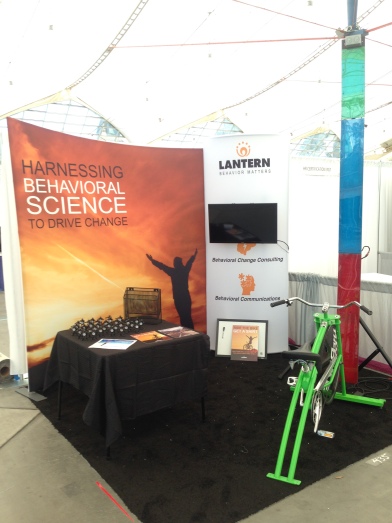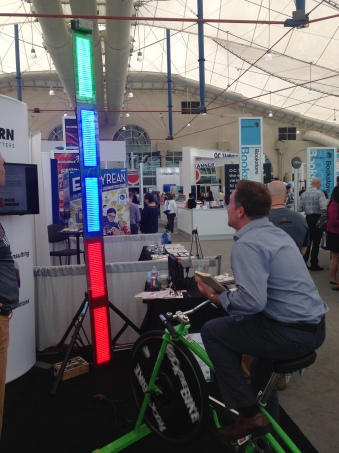Kurt Nelson, PhD and Ben Granlund

As part of our exhibit booth at the World at Work 2016 Total Rewards Conference, we designed a method for giving away our promotional t-shirts that simultaneously acted as an experiment to help us understand what motivates people.
What we found out was intriguing and reinforces some key behavioral insights about intrinsic and extrinsic motivation, recognizing accomplishments and having specific goals.
Our process involved a stationary bike that was hooked up to a bank of LED lights1 – the faster and longer you peddled, the more lights lit up, sounds basic enough right?
The six LED light panels set up on a vertical pole that lit up from the bottom to the top – once all six lights were lit up, all the lights flashed and the process was over.
We set our process up a little differently
To earn a very cool “Behavior Matters” t-shirt, all people needed to do was get on the bike and light up one of the lights.
We did not require that people light all six lights, and we did not assign a time length for peddling to earn a t-shirt. All they had to do was light up one light – a relatively easy process.
Additionally, people could get their name written on our leader board if they were one of the five fastest people to light up all the lights. This white board with hand written names on it was updated whenever someone earned one of the top five spots.
Our original concept was to have people read one of two sets of written rules – one positive and encouraging; the other bland and discouraging. The intent was to see if the different messages impacted how people performed or felt about the activity. We quickly realized that our original plans were not working – too many people wanted to ride the bike and the process ended up being us telling participants the rules instead of them reading them thus invalidating the initial study.
Luckily for us, this is where things got interesting!
Results
While the original communication experiment didn’t pan out, we were still able to gather very interesting findings. Specifically we were intrigued by some of the insights we gained into extrinsic and intrinsic motivation, the power of leader boards, and the impact that specific goals have on performance. First, let’s look at the overall results:
A total of 103 people rode the bike over the two days the exhibit hall was open (some participants rode multiple times). Their performance is shown in table below.
| Highest number of lights lit up | 1 | 2 | 3 | 4 | 5 | 6 |
| # of people achieving level | 1 | 0 | 6 | 14 | 34 | 48 |
| % of people achieving level | 0.9% | 0.0% | 5.8% | 13.6% | 33.0% | 46.6% |
| Average time to reach level (in seconds) |
15 | 0 | 68.7 | 46.1 | 32.5 | 20.6 |
The average ride time was 31.7 seconds – with the fastest time being 4.8 seconds and the longest time being 80 seconds. There is some obvious differences based on physical fitness here as shown by the inverse time required to reach the different levels of lights (i.e., more time on average to reach 3 lights than 4 lights, etc.) which played out in how well people did.
Insights
Do you just want a shirt or are you looking for something more?
We needed to have an incentive to get most people on the bike. True, there were some who just wanted to get on the bike and see how many lights they could get, but the vast majority of the people got on the bike to earn the t-shirt. In other words, they needed an extrinsic reward to participate.
But that’s not the interesting part…
The interesting part was that only one person stopped at the first light (1 out of 103, that’s less than 1%)! Once they were on, the majority of participants moved past the threshold for earning a t-shirt and continued peddling to see what they could do. This was not easy – we had the settings on the bike be rather hard. This meant that peddling for more than 15 seconds was difficult for most non-athletes.
We believe once they started the activity, they intrinsic motivation of the bike kicked in. The lights tracked their progress immediately and they could directly see how they were doing against the goal. They wanted to see what they could accomplish. They no longer worried about the t-shirt – but instead, focused on the event.
In other words, they challenged themselves to see how many lights could they light up?
They had already committed to participate in order to acquire a t-shirt (the reward) – now they were pushing beyond what was required for the shirt because of the challenge that they were presented with. If we think about the 4-Drive Model of Employee Motivation (for more info see here, here, here) we see that the Acquire component was instrumental in the motivation to initiate the event, but the ongoing motivation was propelled by the intrinsic drive to Challenge oneself and see how they could do.
Application:
The idea of using an extrinsic motivator to entice people to participate in programs or activities that they are not excited about and then allowing their natural Challenge drive take-over should not be undervalued. Additionally, the more that a program uses a measure of goal progression, highlighting an individual’s progress, the more a participants Challenge drive is activated. In other words, the design of your extrinsic incentive program can impact the intrinsic motivation that is activated. Finding cohesion between these extrinsic and intrinsic motivators can certainly help drive the right behaviors.
What’s up with the leader board?
We had a leader board where riders got their name featured if they were one of the five fastest people to light up all six lights. They did not earn any additional extrinsic reward for being on the leader board – no fancy give-away, no grand prize, not even an extra t-shirt.
So did it make a difference?







